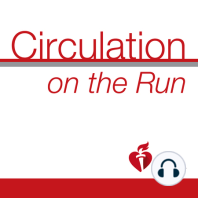17 min listen
Circulation October 20, 2020 Issue
ratings:
Length:
25 minutes
Released:
Oct 19, 2020
Format:
Podcast episode
Description
This week's episode includes author Daniel Lackland and Associate Editor Mercedes Carnethon as they discuss the article "Forty-year Shifting Distribution of Systolic Blood Pressure with Population Hypertension Treatment and Control." TRANSCRIPT BELOW Dr Carolyn Lam: Welcome to Circulation on the Run, your weekly podcast summary and backstage pass to the journal and it's editors. I'm Dr Carolyn Lam, associate editor from the National Heart Center and Duke National University of Singapore. Dr Greg Hundley: And I'm Greg Hundley associate editor, Director of the Pauley Heart Center at VCU Health in Richmond, Virginia. Well, Carolyn, this week's feature is good news. What do I mean by good news? It's going to be a tale of how hypertension has evolved in the Southeastern United States. And it's going to review how that's progressed its treatment efficacy in both those of white, and men and women of black race. But before we get to that, how about we grab a cup of coffee and jump into some of the other articles in this issue. Dr Carolyn Lam: Man, you got my attention, Greg. You definitely got my attention. Dr Greg Hundley: Very good. Well, Carolyn, my first paper is from the world of basic science, and it's from Dr Maya Kumar from Stanford University School of Medicine. This group maps the step wise remodeling of pulmonary arteries in a robust chronic inflammatory mouse model of pulmonary hypertension. A model that demonstrates pathologic features of human disease, including right ventricular pressures, medial thickening, neointimal lesion formation, elastin breakdown, increased anastomosis within the bronchial circulation and perivascular inflammation, all of those combined. And the author sought to define the cell behaviors underlying each stage of vascular remodeling, and identified a pathway required for neointima formation with the premise being that this understanding could be pivotal in modulating progression of disease in pulmonary hypertension. Dr Carolyn Lam: Nice. So what did they find? Dr Greg Hundley: Well, Carolyn, they found surprisingly. The neointima arises from smooth muscle cells and not the endothelium. Medial smooth muscle cells proliferate broadly too thick in the media, after which a small number of smooth muscle cells are selected to establish the neointima. These neointimal founder cells subsequently undergo massive clonal expansion to form occlusive neointimal lesions. The normal pulmonary artery smooth muscle cell population is heterogeneous, and the authors identify a Notch3-marked minority subset of smooth muscle cells as the major neointimal cell of origin. Notch signaling is specifically required for the selection of neointimal founder cells, and Notch inhibition significantly improves pulmonary artery pressure in animals with pulmonary hypertension, thus perhaps providing a new mechanism from which to test therapies to thwart the progression of disease in those with pulmonary hypertension. Very interesting basic science work. Dr Carolyn Lam: Yeah. And very important too. Thanks Greg. Well, I've gotten another basic science paper too. First, let me ask you, do you think of DNA methylation much? Dr Greg Hundley: We hear a lot about that, Carolyn. Methylation and changing DNA and how it might be transcribed. Tell us more. Dr Carolyn Lam: DNA methylation is indeed a mechanism of gene transcription regulation. It's recently gained a lot of attention as a possible therapeutic target in cardiac hypertrophy and heart failure. However, its exact role in cardiomyocytes remains controversial. Thus, the authors Dr Stenzig from University Medical Center, Hamburg-Eppendorf and colleagues knocked out the main de novo DNA methyltransferase in cardiomyocytes. Also, called DNMT3A in human induced pluripotent stem cells. They then assess the functional consequences of DNA methylation deficiency under control and stress conditions in human engineered heart tissue from these knockout derived cardiomyocytes. Dr Gr
Released:
Oct 19, 2020
Format:
Podcast episode
Titles in the series (100)
Circulation January 24, 2017 Issue: Circulation Weekly: Your Weekly Summary & Backstage Pass To The Journal by Circulation on the Run
